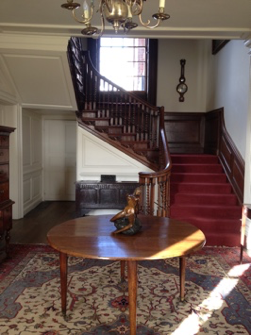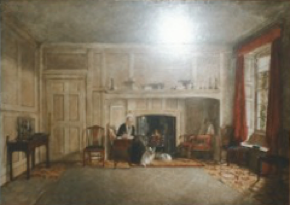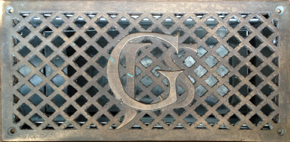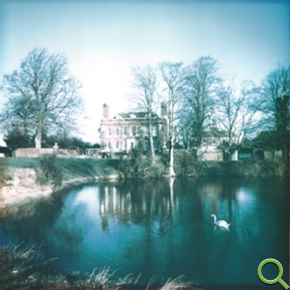Home Gardens Courtyard History Film Privacy
Origins
This charming Grade 1 Georgian house was built by Thomas and Mary Marchant in 1728, with a rear wing built in 1884 and extended in 1936. Thomas and Mary Marchant’s initials and the date 1728 appear on the ornamented rain-water head wings, and Thomas Marchant’s initials and the date 1761 appear on another piece of old pump leadwork.
The 1728 building shows a family likeness in the skilled use of brick to Bradbourne, near East Malling (circa 1715) and West Farleigh Hall (circa 1719), but “the house to which Matfield shows the closest kinship, is Finchcocks, near Goudhurst” (Country Life, July 30th 1921).
Pevsner states that the facade facing south over the village green “must have been designed by the same architect as Finchcocks” (based on evidence from eight common elements in the design) and is referred to by Arthur Oswald in his book Country Houses of Kent where he draws a strong resemblance to Finchcocks. This is interesting as a great deal of work has been done to verify that the Finchcocks facade is the work of Thomas Archer, but unfortunately (as yet) there have been no records found of the building activities or the architect.
Rear Wing

A rear wing was added in 1884 and further extended by Eric Hubbard in 1936. The projecting hood with carved brackets over the east side door, was originally fitted to the old side entrance which opened out of the dining-room into the courtyard, it has now moved a few feet from it’s initial position.
Interior
Entrance Hall

The ample oak staircase arising in the central hall, which reaches through the depth of the house, is an unusually finished example for a house of this modest size and probably unique.
On each tread here are three types of baluster - one tightly twisted, one loosely twisted and one fluted - all with Ionic capitals curiously tilted to conform with the shape of the handrail. Each step has it's end inlaid, to carry on the lines of the balusters, and a well-carved bracket below. The newels take the form of fluted Corinthian colonnettes.
Dining Room

Originally two rooms, one thought to be the Estate Office (this room holds a secret!) and the other a comfortable sitting room with inglenook fireplace.

There is a painting which illustrates the original layout (sadly only a low quality image is available), showing the position of the side door, but now opened up to one big dining area.
Drawing Room
Bedrooms

The bedrooms have been tastefully and faithfully restored, although they are larger than their original size, as the house would have accommodated an altogether bigger household.

As there would have been no associated bathrooms, a couple of the smaller bedrooms have been converted into en-suit bathrooms, their installation being cleverly executed so as not to interfere with the original structure.
Recent
Under the direction of John and Sarah, award winning architect, Nicholas Kidwell, has designed a superb new copper clad extension to the house, replacing a poor quality 1936 structure housing service rooms no longer required for 21st century living. This cube extention has been added to the western side and greatly extends the daily living accommodation and gives a more open and inclusive aspect to the garden, demonstrating what may be accomplished when refurbishing historic structures for modern living.
For the first time in its history the kitchen wing of the house now relates to the garden, but vestiges of the former separation of family and staff can still be seen in the retained internal architectural features and frosted glass of the windows approaching the kitchen, along with the restored call bells.






